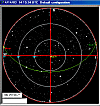 |
Departments
Membership Services
General Info
Financial Info
Activities
Awards
Coordinators
Director's Info
Members' Info
Policies
Forms
Publications
Official Publications
Director's Publications
Ask Dr. SETI ®
Fiction
Non-Fiction
Reviews
Reading Lists
Technical Support
Systems
Antennas
Amplifiers
Receivers
Accessories
Hardware
Software
Press Relations
Fact Sheets
Local Contacts
Editorials
Press Releases
Photo Gallery
Newsletters
Internet Svcs
|
 |

SETI League Photo Gallery
Arecibo Moonbounce Tests, 15 April 2003
Click on the thumbnails below to download full-sized images.

|
The Arecibo Radio Observatory in Puerto Rico, home to the world's largest radio telescope, hosts SETI observations of the California-based SETI Institute's Project Phoenix targeted search. The SETI League collaborated with SETI Institute astronomer Peter Backus to provide moonbounce calibration signals to Arecibo on 15 April 2003. |
|  David Parker / Science Photo Library
|
|
Top: Geodesic distance to the Moon for the month of April 2003. Perigee occurs on 17 April.
Middle: Lunar declination for the month. The Moon passes directly overhead at Arecibo on 12 April.
Bottom: Total EME path degradation for the month. Conditions are optimum between 11 and 15 April.
|
| 


|
|
Top: On 15 April 2003, spatial polarity loss for the moonbounce path between the W2ETI Beacon and Arecibo reaches minimum at 0245 UTC.
Bottom: At 0245 UTC that day, calculated moonbounce success potential reaches a high of 98%. We scheduled to run the test between 0230 and 0330 UTC.
|
| 

|
|
Top: Lunar track (elevation vs. azimuth) as seen from Arecibo on 15 April 2003. The Moon will reach an elevation of 74.8 degrees at zenith (near our peak operating time).
Bottom: Lunar track (elevation vs. azimuth) as seen from the W2ETI Beacon on 15 April 2003. The Moon will reach an elevation of 58.7 degrees at zenith (near our peak operating time).
|
| 

|
From Arecibo, SETI Institute scientists prepare for our moonbounce test.
Top: (l-r) Jill Tarter, Mike Davis
Bottom: (l-r) Seth Shostak, Peter Backus, Mark Langston
SETI Institute SETICam Images
|
|


|
|
In the UK, Manchester University's Jodrell Bank Observatory uses its 250 foot diameter Lovell Telescope as a Follow-Up Detection Device (FUDD), to confirm Project Phoenix detections at Arecibo.
Lovell Telescope WebCam Images
|
| 

|
|
Thanks to the magic of the Internet, SETI League members Muriel Hykes (top) and H. Paul Shuch (bottom) are able to take turns monitoring the action at Arecibo, as well as the status of the W2ETI EME Beacon, during the moonbounce tests.
|
| 

|
|
The Current Status web page enables our members around the world to monitor the beacon's operating parameters in real time.
|
|

|
|
15 April 2003, 0230 UTC: all equipment at the ready, and target in sight.
|
|

|
|
Nova display of mutual window at the beginning of our scheduled moonbounce test.
|
|

|
|
At Arecibo, the Project Phoenix team watches their screens intently for the first evidence of extraterrestrial intelligence from the Moon.
SETI Institute SETICam Images
|
|


|
|
During previous Project Phoenix deployments, the Star Info screen displayed the right ascension, declination, and object being monitored, in real time. During this moonbounce test, the display indicated "no target". It is not yet clear whether this indicates an equipment malfunction, nor can we yet say whether or not Arecibo was actually tracking the Moon.
|
|

|
|
Success! From Arecibo, Dr. Peter Backus confirms that they really are tracking the Moon, the discrepant Star Info screen notwithstanding. And, he tells us that, after correcting an incorrectly flipped switch, our beacon is being received quite loudly at Arecibo. These screen dumps document reception of our CW ID keying, in both of Arecibo's orthogonal polarizations.
|
|


|
|
As an added bonus, our own EME Committee Chairman Allen Katz, K2UYH, writes, "I did check out the beacon last night and it looked great. Frequency agreed with my new GPS standard." Al uses a backyard 28 foot dish. It doesn't take an Arecibo...
|
|

|
|






















